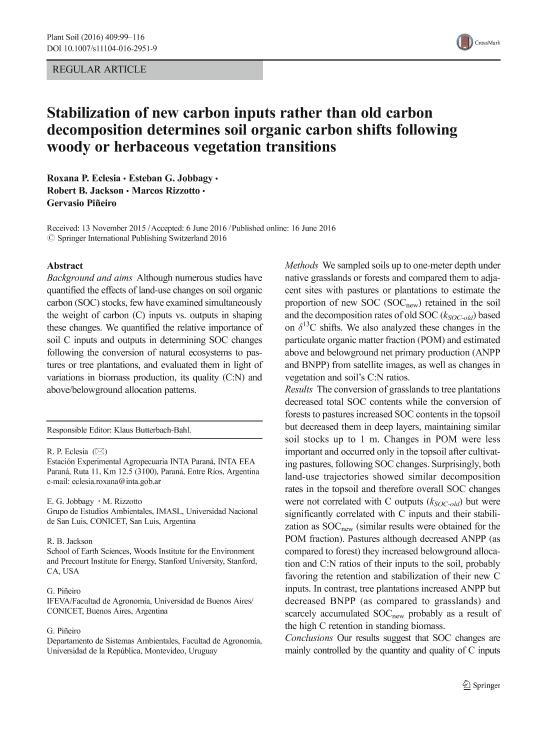Mostrar el registro sencillo del ítem
dc.contributor.author
Eclesia, Roxana Paola

dc.contributor.author
Jobbagy Gampel, Esteban Gabriel

dc.contributor.author
Jackson, Robert B.

dc.contributor.author
Rizzotto, Marcos Gregorio

dc.contributor.author
Piñeiro, Gervasio

dc.date.available
2018-07-13T19:05:10Z
dc.date.issued
2016-12
dc.identifier.citation
Eclesia, Roxana Paola; Jobbagy Gampel, Esteban Gabriel; Jackson, Robert B.; Rizzotto, Marcos Gregorio; Piñeiro, Gervasio; Stabilization of new carbon inputs rather than old carbon decomposition determines soil organic carbon shifts following woody or herbaceous vegetation transitions; Springer; Plant and Soil; 409; 1-2; 12-2016; 99-116
dc.identifier.issn
0032-079X
dc.identifier.uri
http://hdl.handle.net/11336/52081
dc.description.abstract
Background and aims: Although numerous studies have quantified the effects of land-use changes on soil organic carbon (SOC) stocks, few have examined simultaneously the weight of carbon (C) inputs vs. outputs in shaping these changes. We quantified the relative importance of soil C inputs and outputs in determining SOC changes following the conversion of natural ecosystems to pastures or tree plantations, and evaluated them in light of variations in biomass production, its quality (C:N) and above/belowground allocation patterns. Methods: We sampled soils up to one-meter depth under native grasslands or forests and compared them to adjacent sites with pastures or plantations to estimate the proportion of new SOC (SOCnew) retained in the soil and the decomposition rates of old SOC (kSOC-old) based on δ13C shifts. We also analyzed these changes in the particulate organic matter fraction (POM) and estimated above and belowground net primary production (ANPP and BNPP) from satellite images, as well as changes in vegetation and soil’s C:N ratios. Results: The conversion of grasslands to tree plantations decreased total SOC contents while the conversion of forests to pastures increased SOC contents in the topsoil but decreased them in deep layers, maintaining similar soil stocks up to 1 m. Changes in POM were less important and occurred only in the topsoil after cultivating pastures, following SOC changes. Surprisingly, both land-use trajectories showed similar decomposition rates in the topsoil and therefore overall SOC changes were not correlated with C outputs (kSOC-old) but were significantly correlated with C inputs and their stabilization as SOCnew (similar results were obtained for the POM fraction). Pastures although decreased ANPP (as compared to forest) they increased belowground allocation and C:N ratios of their inputs to the soil, probably favoring the retention and stabilization of their new C inputs. In contrast, tree plantations increased ANPP but decreased BNPP (as compared to grasslands) and scarcely accumulated SOCnew probably as a result of the high C retention in standing biomass. Conclusions: Our results suggest that SOC changes are mainly controlled by the quantity and quality of C inputs and their retention in the soil, rather than by C outputs in these perennial subtropical ecosystems.
dc.format
application/pdf
dc.language.iso
eng
dc.publisher
Springer

dc.rights
info:eu-repo/semantics/openAccess
dc.rights.uri
https://creativecommons.org/licenses/by-nc-sa/2.5/ar/
dc.subject
DECOMPOSITION RATE
dc.subject
LANDS USE CHANGE
dc.subject
ROOTS
dc.subject
SOIL ORGANIC CARBON
dc.subject.classification
Química Orgánica

dc.subject.classification
Ciencias Químicas

dc.subject.classification
CIENCIAS NATURALES Y EXACTAS

dc.title
Stabilization of new carbon inputs rather than old carbon decomposition determines soil organic carbon shifts following woody or herbaceous vegetation transitions
dc.type
info:eu-repo/semantics/article
dc.type
info:ar-repo/semantics/artículo
dc.type
info:eu-repo/semantics/publishedVersion
dc.date.updated
2018-06-22T14:35:21Z
dc.identifier.eissn
1573-5036
dc.journal.volume
409
dc.journal.number
1-2
dc.journal.pagination
99-116
dc.journal.pais
Alemania

dc.journal.ciudad
Berlin
dc.description.fil
Fil: Eclesia, Roxana Paola. Instituto Nacional de Tecnología Agropecuaria. Centro Regional Entre Ríos. Estación Experimental Agropecuaria Paraná; Argentina
dc.description.fil
Fil: Jobbagy Gampel, Esteban Gabriel. Consejo Nacional de Investigaciones Científicas y Técnicas. Centro Científico Tecnológico Conicet - San Luis. Instituto de Matemática Aplicada de San Luis "Prof. Ezio Marchi". Universidad Nacional de San Luis. Facultad de Ciencias Físico, Matemáticas y Naturales. Instituto de Matemática Aplicada de San Luis "Prof. Ezio Marchi"; Argentina
dc.description.fil
Fil: Jackson, Robert B.. University of Stanford; Estados Unidos
dc.description.fil
Fil: Rizzotto, Marcos Gregorio. Consejo Nacional de Investigaciones Científicas y Técnicas. Centro Científico Tecnológico Conicet - San Luis. Instituto de Matemática Aplicada de San Luis "Prof. Ezio Marchi". Universidad Nacional de San Luis. Facultad de Ciencias Físico, Matemáticas y Naturales. Instituto de Matemática Aplicada de San Luis "Prof. Ezio Marchi"; Argentina
dc.description.fil
Fil: Piñeiro, Gervasio. Consejo Nacional de Investigaciones Científicas y Técnicas. Oficina de Coordinación Administrativa Parque Centenario. Instituto de Investigaciones Fisiológicas y Ecológicas Vinculadas a la Agricultura. Universidad de Buenos Aires. Facultad de Agronomía; Argentina. Universidad de la República; Uruguay
dc.journal.title
Plant and Soil

dc.relation.alternativeid
info:eu-repo/semantics/altIdentifier/doi/http://dx.doi.org/10.1007/s11104-016-2951-9
dc.relation.alternativeid
info:eu-repo/semantics/altIdentifier/url/https://link.springer.com/article/10.1007/s11104-016-2951-9
Archivos asociados
